- 首页
- 公司介绍
- 热门促销
-
全部产品
-
试剂盒
- |
-
一抗
- |
-
二抗
- |
-
蛋白
- |
-
免疫组化试剂
- |
-
WB 试剂
- PonceauS Staining Solution
- PBST Washing Buffer, 10X
- 1.5M Tris-HCl Buffer, pH8.8
- 1M Tris-HCl Buffer, pH6.8
- 10% SDS Solution
- Prestained Protein Marker
- TBST Washing Buffer, 10X
- SDS PAGE Loading Buffer, 5X
- Stripping Buffered Solution
- Tris Buffer, pH7.4, 10X
- Total Protein Extraction Kit
- Running Buffer, 10X
- Transfer Buffer, 10X
- 30% Acr-Bis(29:1) Solution
- Tris电泳液速溶颗粒
- PBS(1X, premixed powder)
- TBS(1X, premixed powder)
- 快速封闭液
- 转膜液速溶颗粒
- Chemical reagents
- 公司新闻
- 营销网络
- 资源中心
- 联系我们
TDH rabbit pAb
- 货号:YT7048
- 应用:WB
- 种属:Human;Mouse
- 免疫原:
- Synthesized peptide derived from human TDH AA range: 169-219
- 特异性:
- This antibody detects endogenous levels of TDH at Human/Mouse
- 组成:
- Liquid in PBS containing 50% glycerol, 0.5% BSA and 0.02% sodium azide.
- 来源:
- Polyclonal, Rabbit,IgG
- 纯化工艺:
- The antibody was affinity-purified from rabbit antiserum by affinity-chromatography using epitope-specific immunogen.
- 储存:
- -15°C to -25°C/1 year(Do not lower than -25°C)
- 背景:
- This gene appears to be an evolving pseudogene of L-threonine 3-dehydrogenase (TDH). In both prokaryotes and eukaryotes, TDH catalyzes the first of two steps in one of two L-threonine degradation pathways. However, in human, the single gene with sequence similarity to TDH is not capable of encoding a functional TDH protein; the predicted protein lacks most of the C-terminus and parts of the NAD+ binding motif when compared to other species' TDH proteins. This suggests that the human gene is therefore a pseudogene. Transcripts of this gene are found in all tissues and alternatively spliced transcripts have been described. It is not known if these transcripts are translated, or if the possible protein product provides any functional role. [provided by RefSeq, Jul 2008],
- 功能:
- caution:According to PubMed:12361482, the human TDH gene is an expressed pseudogene encoding non-functional truncated proteins that are unable to make appropriate contacts with the substrates, L-threonine and NAD(+). Although all exons expected to encode a functional L-threonine 3-dehydrogenase of 369 residues are present in the human genome, all transcripts described encode truncated proteins that result from mutations within the gene causing the loss of acceptor splice site preceding exon 4 and exon 6.,similarity:Belongs to the sugar epimerase family.,tissue specificity:Expressed in all tissues examined. Detected in most cell types examined, but not observed in endothelial cells, glioma cell lines and some leukemia cell lines.,
- 组织表达:
- Expressed in all tissues examined. Detected in most cell types examined, but not observed in endothelial cells, glioma cell lines and some leukemia cell lines.

- Western blot analysis of lysates from MDA-MB cells, primary antibody was diluted at 1:1000, 4°over night




